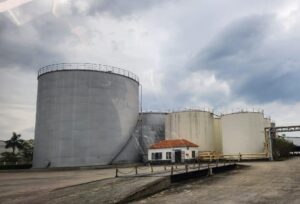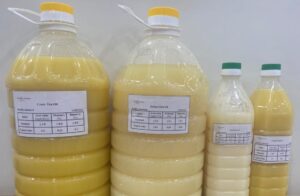Fish Oil for Biodiesel Production
 Fish oil can be used as a feedstock for biodiesel production, although it is not as commonly used as vegetable oils or animal fats. Biodiesel is a renewable fuel that can be produced from various feedstocks, including oils and fats.
Fish oil can be used as a feedstock for biodiesel production, although it is not as commonly used as vegetable oils or animal fats. Biodiesel is a renewable fuel that can be produced from various feedstocks, including oils and fats.
Fish oil contains triglycerides, which are the main components used to produce biodiesel. The process of converting fish oil into biodiesel is similar to that of other feedstocks. Here are the general steps involved in biodiesel production from fish oil:
Pre-treatment: The fish oil is processed to remove impurities such as water, free fatty acids, and solid particles. This is usually done through filtration and/or centrifugation.
Transesterification: The pre-treated fish oil is reacted with an alcohol, typically methanol, in the presence of a catalyst (such as sodium hydroxide or potassium hydroxide). This reaction, known as transesterification, converts the triglycerides into fatty acid methyl esters (FAME), which are the main components of biodiesel. Glycerol is produced as a byproduct.
 Separation and purification: The mixture of FAME and glycerol is allowed to settle, and the glycerol layer is separated from the biodiesel. The biodiesel is then washed with water to remove any remaining impurities.
Separation and purification: The mixture of FAME and glycerol is allowed to settle, and the glycerol layer is separated from the biodiesel. The biodiesel is then washed with water to remove any remaining impurities.
Drying and filtering: The washed biodiesel is dried to remove any remaining water and then filtered to remove any particulate matter.
Quality testing: The final biodiesel product is tested to ensure it meets the necessary quality standards, such as ASTM (American Society for Testing and Materials) specifications.
It’s worth noting that fish oil as a feedstock for biodiesel production has certain considerations and challenges. For instance, fish oil is generally more expensive compared to other feedstocks, which can affect the economics of biodiesel production. Additionally, the availability of fish oil in large quantities may be limited, especially if it competes with other applications such as fishmeal production or dietary supplements.
Overall, while fish oil can be used for biodiesel production, its utilization is not as widespread as other feedstocks due to availability considerations.
Catfish Oil
Catfish oil can be used as a feedstock for biodiesel production, and it offers certain benefits in terms of burn rate. Biodiesel produced from catfish oil has been found to have good combustion properties, which can positively affect the burn rate and overall performance of the fuel. Here are some potential benefits:
High energy content: Catfish oil, like other fish oils, is rich in triglycerides, which are converted into fatty acid methyl esters (FAME) during the biodiesel production process. FAMEs have a high energy content, which can result in efficient combustion and a higher burn rate compared to some other biodiesel feedstocks.
Lower viscosity: Biodiesel produced from catfish oil tends to have a lower viscosity compared to biodiesel from certain vegetable oils. Lower viscosity means the fuel flows more easily, allowing for better atomization and combustion in diesel engines. This can contribute to improved burn rate and combustion efficiency.
Good cetane number: The cetane number is a measure of the ignition quality of diesel fuels. Biodiesel derived from catfish oil has been found to have a relatively high cetane number, which indicates good ignition properties. A higher cetane number can lead to faster and more complete combustion, resulting in a better burn rate.
Reduced emissions: Biodiesel produced from catfish oil generally exhibits lower levels of harmful emissions, such as particulate matter, carbon monoxide, and sulfur compounds, compared to conventional petroleum diesel. The cleaner combustion of biodiesel can contribute to a more efficient and environmentally friendly burn rate.
It’s important to note that the exact burn rate and performance of biodiesel can depend on various factors, including the specific composition of the feedstock, the production process, and the engine technology. Therefore, thorough testing and optimization are necessary to determine the burn rate and overall performance of biodiesel derived from catfish oil in specific applications.
